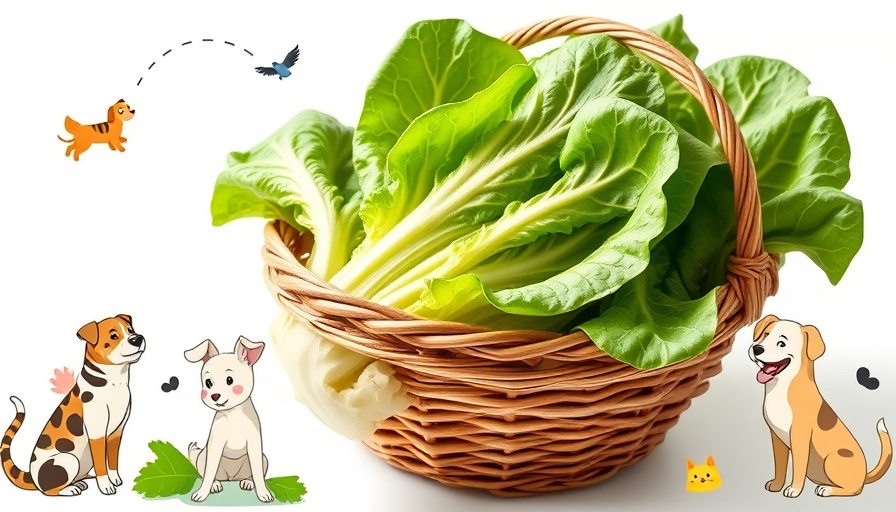
Unpacking the Health Benefits of Romaine Lettuce for Pets
Romaine lettuce might conjure images of fresh salads and summertime picnics, but it shouldn’t be dismissed as just another green. This leafy vegetable not only awakens your taste buds but can also serve as a surprising and nutritious treat for our furry friends. Fresh, crunchy romaine lettuce is a water-rich vegetable that, despite being made up of about 90% water, is packed with nutrients such as polyphenols and dietary fiber that can contribute positively to your pet's health.
Understanding Polyphenols: The Unsung Heroes
Polyphenols, a type of bioactive compound found abundantly in romaine lettuce, play a significant role in promoting overall health in pets. Research indicates that these compounds can help manage inflammation and regulate genes associated with obesity and liver fat accumulation. For instance, a 2009 study noted significant improvements in immune responses in dogs that consumed polyphenol-rich diets. This highlights the potential of polyphenols not just for enhancing general well-being but also for bolstering the immune response in our companions.
Fiber: Essential for Digestive Health
Including fiber-rich foods in your pet’s diet is crucial for maintaining digestive health. Romaine lettuce is an excellent source of dietary fiber, which aids in digestion, alleviates constipation, and prevents gastrointestinal problems like diarrhea. Fiber facilitates regular bowel movements, resulting in a happier gut for your pet. However, it’s essential to serve it moderately; excess fiber can lead to gastrointestinal upset. As such, rotating romaine lettuce with other fresh vegetables will help avoid any digestive issues while still providing variety to your pet's diet.
Romaine Lettuce vs. Other Vegetables: What Sets It Apart?
When it comes to choosing treats for dogs and cats, the variety of vegetables available can be overwhelming. While carrots and bell peppers are commonly praised, romaine lettuce holds its own with a unique blend of hydration and nutrient density. It’s easy to prepare, just rinse, chop, and serve. Moreover, since many pets enjoy the crunchy texture, it can be a great way to keep them engaged — a natural chew toy, if you will!
Practical Tips for Adding Romaine to Your Pet’s Diet
Integrating romaine lettuce into your pet's diet can be seamless with these practical tips:
- Start Small: Initially offer small pieces to see how your pet reacts. This approach helps gauge any sensitivities they might have.
- Mix it Up: Use romaine lettuce as a base and create colorful bowls with various other veggies like carrots, peas, and broccoli for a delightful mix of flavors.
- Homemade Treats: Consider making frozen veggie pops with blended romaine lettuce and water for a refreshing snack during warmer months!
Addressing Myths: Is Romaine Lettuce Safe for All Pets?
Many pet owners might wonder whether romaine lettuce is universally safe for dogs and cats. While it is a nutritious option, it’s crucial to recognize the potential for individual digestive sensitivities. Not all pets will have the same reaction; while many can enjoy romaine as a treat, others with certain gastrointestinal issues may find it bothersome. Always consult with your veterinarian when incorporating new treats into your pet's diet, especially if they have pre-existing health conditions.
Conclusion: A Crunchy Treat for Better Health
As pet owners, we are continually seeking ways to contribute positively to our pets' lives. Romaine lettuce can be an ideal addition to a healthy treat rotation, showing that even simple greens can pack a powerful health punch. By providing a balance of treats and maintaining an active lifestyle, we can enhance our pets' well-being. Remember, always listen to your furry friends' needs and adjust their diet accordingly to ensure they thrive!
For pet lovers eager to build healthier habits for their companions, exploring new food options can lead to surprising benefits that contribute to a long, happy life together. So the next time you're prepping a salad, consider chopping up some romaine lettuce to share with your furry friend — they might just thank you with a wagging tail or a playful purr!
 Add Row
Add Row  Add
Add 




Write A Comment